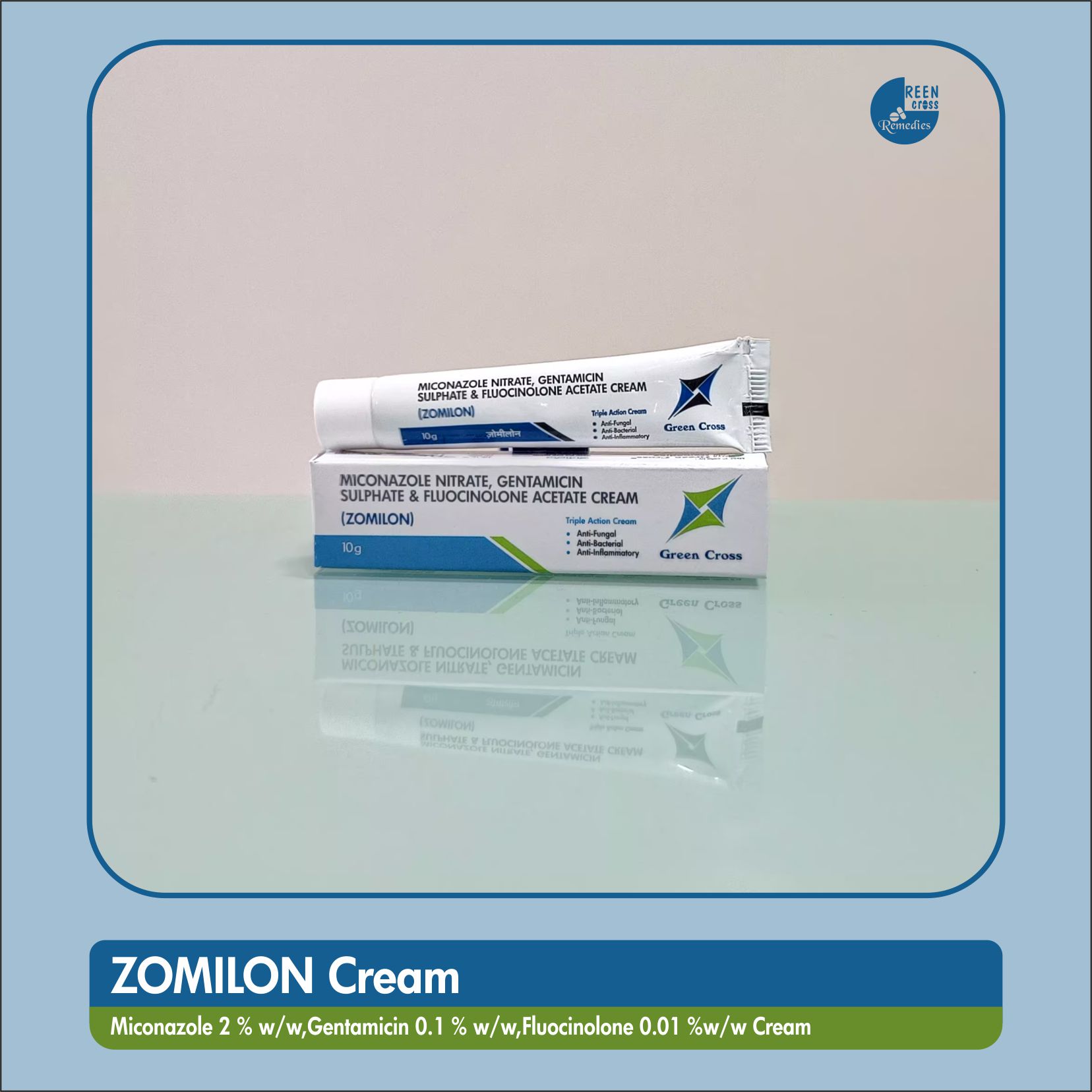ZOMILON Cream

Miconazole 2 % w/w,Gentamicin 0.1 % w/w,Fluocinolone 0.01 %w/w Cream Use, Indication, Side Effects, Dosage, Mechanism of Action, Price, Contra-Indications, Drug Interactions...
ZOMILON Cream (Miconazole 2%, Gentamicin 0.1%, Fluocinolone 0.01%)
ZOMILON Cream is a topical formulation that combines three active ingredients: Miconazole, Gentamicin, and Fluocinolone. It is commonly used to treat a variety of skin conditions, particularly those involving fungal and bacterial infections, as well as inflammatory skin disorders.
Active Ingredients:
-
Miconazole (2%): An antifungal agent.
-
Gentamicin (0.1%): An antibiotic (aminoglycoside).
-
Fluocinolone (0.01%): A corticosteroid with anti-inflammatory properties.
Uses and Indications:
ZOMILON Cream is used to treat the following conditions:
- Fungal Skin Infections: Miconazole targets fungal infections, such as athlete's foot, ringworm, and jock itch.
- Bacterial Skin Infections: Gentamicin is effective against certain bacterial infections on the skin, including those caused by Staphylococcus aureus and Streptococcus species.
- Inflammatory Skin Disorders: Fluocinolone, a corticosteroid, helps to reduce inflammation, redness, and swelling associated with conditions such as eczema, dermatitis, and psoriasis.
- Mixed Infections: Effective in treating skin infections that involve both fungal and bacterial components.
- Superficial Skin Infections: Useful in managing infections caused by both fungi and bacteria.
Mechanism of Action:
- Miconazole: Miconazole works by inhibiting the synthesis of ergosterol, an essential component of fungal cell membranes, leading to the disruption of cell membrane integrity and ultimately fungal cell death.
- Gentamicin: Gentamicin works by inhibiting bacterial protein synthesis, which prevents bacteria from reproducing and leads to bacterial cell death.
- Fluocinolone: Fluocinolone is a corticosteroid that works by suppressing the inflammatory response. It reduces the production of inflammatory mediators such as prostaglandins, leukotrienes, and cytokines, thus reducing redness, swelling, and itching.
Dosage:
- Apply a thin layer of ZOMILON Cream to the affected area of the skin.
- The cream should be applied 1-2 times daily or as prescribed by the healthcare provider.
- Treatment duration varies depending on the type and severity of the infection. It should not be used for extended periods unless directed by a healthcare professional.
Note: Always follow the specific instructions given by your doctor or pharmacist.
Side Effects:
Like all medications, ZOMILON Cream can cause side effects, though not everyone may experience them. Some possible side effects include:
- Local Skin Reactions:
- Redness, burning, stinging, or itching at the application site.
- Dryness, peeling, or rash at the treated area.
- Thinning of the Skin (with prolonged use due to the corticosteroid component).
- Allergic Reactions: Rare but may include swelling, hives, or difficulty breathing.
- Systemic Effects: If absorbed through the skin, corticosteroids like Fluocinolone may cause systemic side effects, including hormonal imbalances or immunosuppressant, but this is unlikely when used topically for short periods.
Contraindications:
ZOMILON Cream should not be used in the following situations:
- Hypersensitivity: If you are allergic to any of the active ingredients (Miconazole, Gentamicin, Fluocinolone), you should avoid using this cream.
- Viral Skin Infections: It should not be applied to skin infected with viruses like herpes simplex (cold sores) or chickenpox.
- Tuberculosis: Active tuberculosis of the skin or untreated fungal infections should be avoided.
- Open Wounds: Avoid using on large open wounds or damaged skin.
- Prolonged Use: Prolonged use of corticosteroids like Fluocinolone should be avoided unless directed by a doctor.
Drug Interactions:
- Topical corticosteroids (Fluocinolone): If used in combination with other corticosteroids, this may increase the risk of systemic absorption, leading to potential side effects.
- Topical Antibiotics (Gentamicin): Gentamicin is unlikely to have significant interactions when used topically but should be used cautiously with other antibiotics to avoid resistance development.
- Antifungal (Miconazole): No significant interactions with other antifungal are noted, but it is always best to inform your doctor of any other antifungal treatments you may be using.
For Use of registered medical practitioner or a hospital only

